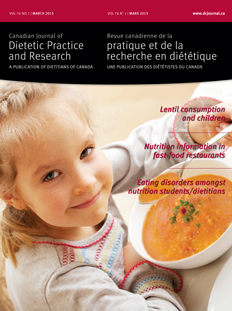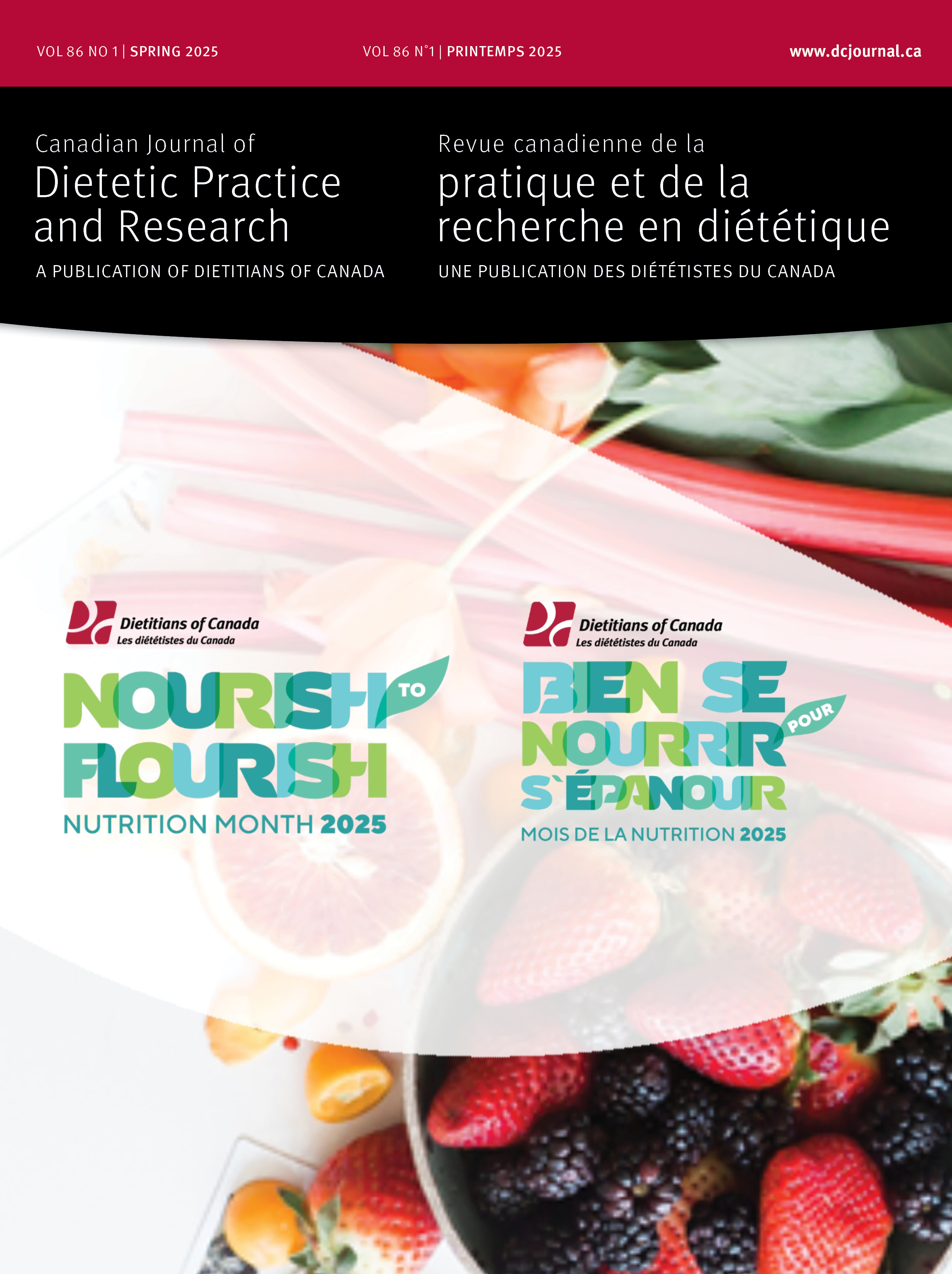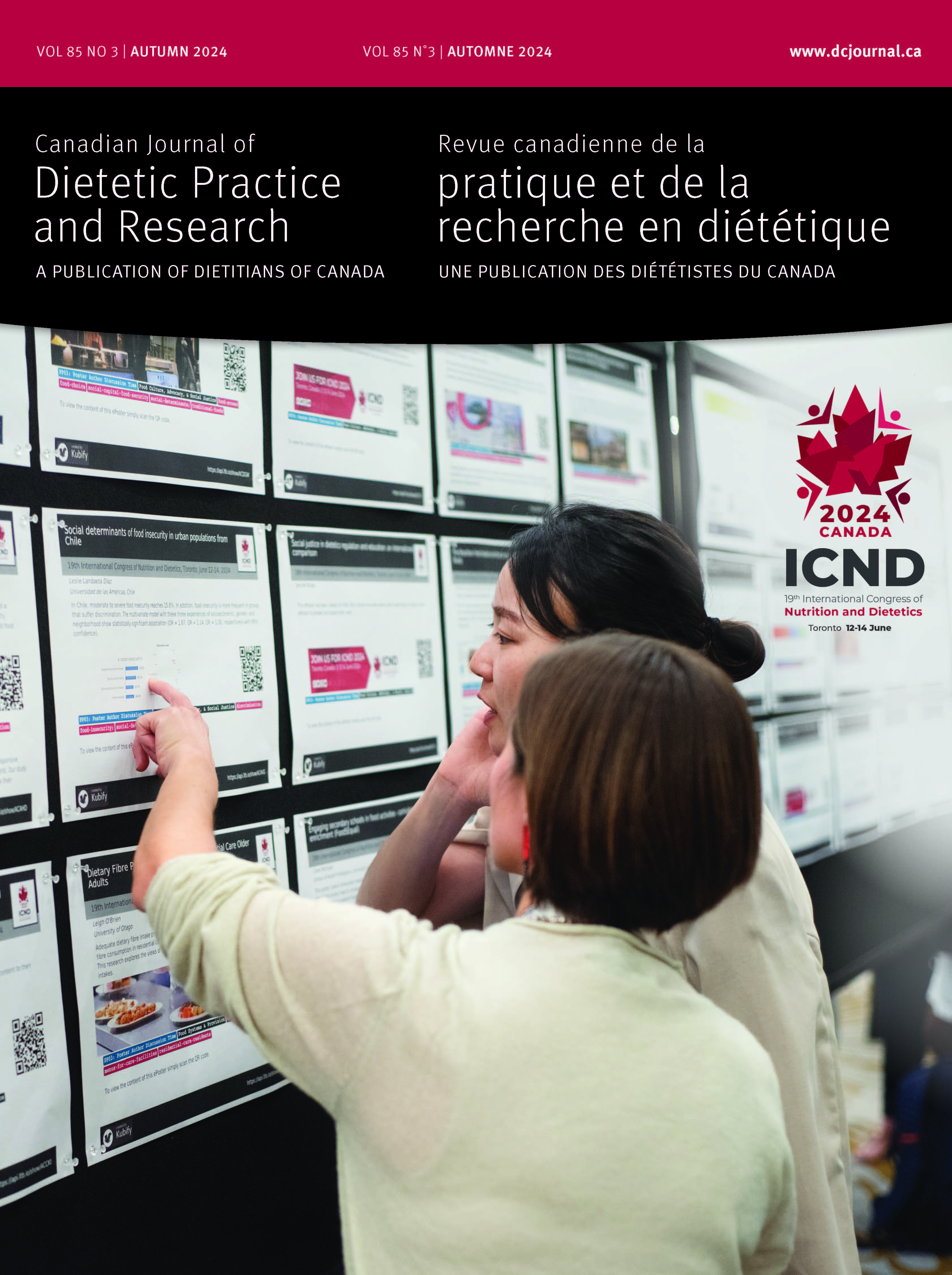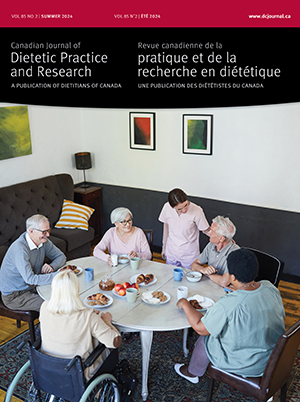Volume 76 • Number 1 • March 2015
Chair's Message
Editor's Message
Original Research
Purpose: Plant-based diets are advocated for prevention of chronic diseases. Lentils are an inexpensive plant-based meat alternative. This study determined perceived benefits and barriers to lentil consumption and how they relate to the demographics and nutritional knowledge of caregivers and consumption habits in families with children 3–11 years of age. Methods: A self-administered questionnaire measuring nutritional knowledge and perceived benefits and barriers to the consumption of lentils was completed by 401 caregivers in a school setting in Saskatoon, Saskatchewan. Results: The majority of respondents were 26–45 years of age (83%) and female (76%). Respondents associated lentils with health benefits (91%). The most frequently reported barrier associated with consumption pertained to family acceptance: “if my child liked lentils I would make them more” (76% agreement). More than half (58%) of respondents stated they “never or rarely” consumed lentils (low-consumers). Of low-consumers, top barriers included lack of knowledge on how to cook lentils and a belief that family members would not accept lentils. Conclusions: Future promotion strategies should address the top barriers to lentil consumption. An understanding of the perceived benefits and barriers surrounding lentil consumption will help formulate approaches to increase consumption of lentils as well as pulses.
Purpose: NutriSTEP® screens for nutritional risk in preschoolers (3–5 years of age). Availability has been limited to paper versions. The objective is to test reliability for Internet and Onscreen use. Methods: Two studies were conducted with parents in several Ontario Early Years Centres (Internet (n = 63)) and in the community and schools in Timmons, Guelph, and Ottawa, Ontario (Onscreen (n = 64)). Parents completed NutriSTEP® either on paper or using Internet or Onscreen versions. Two weeks later, the alternate mode was completed. Reliability was assessed using Intraclass Correlations (ICC) and Pearson Correlations (PC) on total and attribute scores, Kappa coefficients (κ) for risk, and Wilcoxon Signed Rank Test for responses on individual questions. Results: For total scores, Internet and Onscreen ICCs were 0.94 and 0.91, respectively, with PCs of 0.89 and 0.84, respectively. Attribute scores were 0.69–0.91 (ICC) and 0.70–0.84 (PC) for Internet, and 0.81–0.92 (ICC) and 0.68–0.85 (PC) for Onscreen. κ amongst risk categories was 0.58 (P = 0.000) for Internet and 0.50 (P = 0.000) for Onscreen. For individual dichotomized questions, 5 of 17 (Onscreen and Internet) were excellent (κ > 0.75); 11 of 17 (Internet) and 9 of 17 (Onscreen) were adequate (0.40 < κ > 0.75); 0 of 17 (Internet) and 2 of 17 (Onscreen) questions were poor (κ < 0.4) in agreement between modes. Conclusions: Internet and Onscreen versions of NutriSTEP® are reliable.
Purpose: To explore the meanings that dietitians associate with their role of mother and dietitian and how they translate into child-feeding practices. Methods: The ideological case-study approach of Interpretative Phenomenological Analysis, a qualitative research design, was utilized. A convenience sample of 3 dietitians was recruited from the faculty of a university nutrition department. Dietitians participated in semi-structured interviews that were voice-recorded and transcribed. Data were thematically organized and interpreted using the theory of Symbolic Interactionism. Results: Five themes were developed: the evolution of food-related practices, tensions between the role of dietitian and mother, mealtime interaction, integration of dietetic values in child-feeding practices, and the individuality of the mother. Dietitian mothers used various parenting styles when interacting with their children. Their beliefs about best practice in child-feeding correspond with the recommendations of their dietetic profession. Their perception of what it meant to be a good mother was influenced by their identity as a dietitian. Relevance to Practice: Dietitian mothers need to be aware of the influence of professional discourse; professional thoughts can influence personal thoughts and actions related to child-feeding practices. Further exploration of the topic including maternal and child-feeding practices from the child's perspective is warranted.
Objectif. L'objectif principal est de vérifier la perception qu'ont les étudiants en nutrition du Québec de l'avenir de la profession à partir d'incidents critiques qu'ils ont rapportés. Méthodes. Un questionnaire électronique a été envoyé aux 158 étudiants finissants en nutrition des trois universités du Québec offrant un programme de nutrition. La méthode des incidents critiques a été retenue comme méthode qualitative. Une grille de thèmes et sous-thèmes dégagés de l'analyse des incidents a été mise au point puis intégrée au logiciel Excel pour synthétiser les données. Résultats. Les incidents positifs étaient associés à la reconnaissance des autres professionnels et de la clientèle, à la prise de conscience des champs d'action de la profession et des occasions qui s'y rattachent, ainsi qu’à l'impact des interventions nutritionnelles. Les incidents négatifs touchaient principalement le manque de reconnaissance, la concurrence, la prise de conscience de possibilités d'emploi limitées, les conditions de travail et l'affirmation des diététistes par rapport à leur rôle. La plupart des incidents rapportés sont survenus en stage. Conclusions. Les compétences en leadership devraient être développées pour aider les diététistes à s'affirmer au sein des équipes de soins et sur la scène publique. Par ailleurs, les expériences de stage sont déterminantes dans le développement de l'image que se font les étudiants de la profession.
Purpose: We explored the characteristics of Ontario-based dietetic internship program applicants who were successful upon their first application attempt, and we made comparisons between those who were successful and unsuccessful on their first internship application attempt. Methods: A 32-item online survey was distributed to graduates from nutrition programs in Ontario and to members of the Dietitians of Canada Student Network, Toronto Home Economics Association, and Ontario Home Economists in Business. Data from a previous study examining the characteristics of unsuccessful internship applicants were obtained from the authors to compare the two groups. Results: Respondents (n = 76) were mostly female (97%), 20–25 years of age (67%), and had a previous degree (46%). Compared with those who were unsuccessful on their first internship application attempt, those who were successful had a significantly higher mean cGPA (3.69 ± 0.39 vs. 3.35 ± 0.41), were more likely to have a prior degree (46% vs. 29%), spent more time preparing their internship application package, and perceived their internship application packages to be stronger. Conclusions: Despite some differences, most applicants met the minimum cGPA requirement outlined by internship programs in Ontario. More internship opportunities can help increase the diversity and human potential in the dietetic profession.
Perspectives in Practice
The high prevalence of obesity and its metabolic co-morbidities require dietitians to promote lifestyle modifications that can be effectively implemented into practice and are feasible for customers to adhere to. The objective of this study was to determine the effect of commercially available ready-to-eat canned navy beans added to the habitual diet on risk factors associated with obesity. Fourteen overweight and obese adults consumed 5 cups of canned navy beans per week for 4 weeks. The study results demonstrated that bean consumption results in reduced waist circumference in females by 2.5 cm and males by 2.1 cm (P < 0.001). The effect of beans on pulse rate, total cholesterol (TC), and low-density lipoprotein cholesterol (LDL) were sex dependent (P < 0.05). In males, pulse rate, TC, and LDL were decreased by 6.5%, 11.5%, and 18%, respectively. In females, pulse rate increased by 9.6%, and TC and LDL were relatively unchanged. There was a trend for a decreased glucose AUC (P = 0.06) in response to a glucose load. This study demonstrates that consuming 5 cups per week of ready-to-eat canned navy beans for 4 weeks reduces metabolic risk factors associated with obesity and therefore can be used as a tool in dietetic practice.
Review
The diet industry and media have a powerful influence over women, leading many to believe that they must modify their appearance for societal acceptance. Dietetics, as one of many predominantly female professions, may be particularly vulnerable to these pressures. An integrative review process was used to examine eating disorders and disordered eating within the dietetics profession with the aim to both synthesize existing data and develop questions for future research. Seventeen articles were reviewed using broad search terms and dates because of the dearth of available literature. Given nutrition programs and dietetic practice often involve significant exposure to food, ideas and opinions about food, weight, and its place in health and dietetic practice researchers were compelled to ask “why”. Findings were organized under 3 categories including thinness ideology, implications of food and body associated with nutrition or dietetic education, and establishment of a continuum. This review serves as a platform to inspire future research in an understudied but important topic related to dietetic education and practice. Minimally as a profession, baseline data need to be collected to understand the prevalence of disordered eating and eating disorders along the continuum of practice in Canada.
Report
Purpose: To assess the availability, location, and format of nutrition information in fast-food chain restaurants in Ontario. Methods: Nutrition information in restaurants was assessed using an adapted version of the Nutrition Environment Measures Study for Restaurants (NEMS-R). Two raters independently visited 50 restaurants, 5 outlets of each of the top-10 fast-food chain restaurants in Canada. The locations of the restaurants were randomly selected within the Waterloo, Wellington, and Peel regions in Ontario, Canada. Descriptive results are presented for the proportion of restaurants presenting nutrition information by location (e.g., brochure), format (e.g., use of symbols), and then by type of restaurant (e.g., quick take-away, full-service). Results: Overall, 96.0% (n = 48) of the restaurants had at least some nutrition information available in the restaurant. However, no restaurant listed calorie information for all items on menu boards or menus, and only 14.0% (n = 7) of the restaurants posted calorie information and 26.0% (n = 13) of restaurants posted other nutrients (e.g., total fat) for at least some items on menus boards or menus. Conclusions: The majority of the fast-food chain restaurants included in our study provided at least some nutrition information in restaurants; however, very few restaurants made nutrition information readily available for consumers on menu boards and menus.










